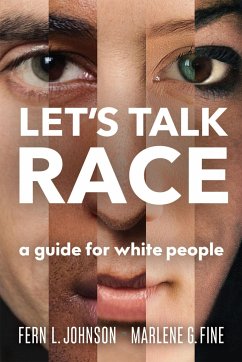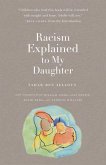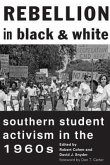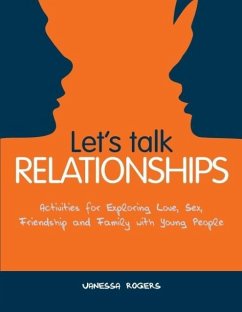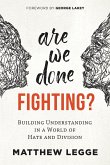15,99 €
inkl. MwSt.
Versandfertig in über 4 Wochen

8 °P sammeln
- Broschiertes Buch
- Merkliste
- Auf die Merkliste
- Bewerten Bewerten
- Teilen
- Produkt teilen
- Produkterinnerung
- Produkterinnerung
Racial equity begins with meaningful interracial conversations. Let's Talk Race: A Guide for White People explores why white people struggle to talk about race, why we need to talk about race to energize social action, and how to create the safe spaces for these conversations to take place.
Andere Kunden interessierten sich auch für
![Racism Explained to My Daughter Racism Explained to My Daughter]() Tahar Ben JellounRacism Explained to My Daughter18,99 €
Tahar Ben JellounRacism Explained to My Daughter18,99 €![Rebellion in Black and White Rebellion in Black and White]() Rebellion in Black and White34,99 €
Rebellion in Black and White34,99 €![Let's Talk Relationships Let's Talk Relationships]() Vanessa RogersLet's Talk Relationships31,99 €
Vanessa RogersLet's Talk Relationships31,99 €![We Don't Talk About It. Ever: Secrets. Sin. Sex. Salvation We Don't Talk About It. Ever: Secrets. Sin. Sex. Salvation]() Desiree-Anne MartinWe Don't Talk About It. Ever: Secrets. Sin. Sex. Salvation13,99 €
Desiree-Anne MartinWe Don't Talk About It. Ever: Secrets. Sin. Sex. Salvation13,99 €![Selma's Bloody Sunday Selma's Bloody Sunday]() Robert A PrattSelma's Bloody Sunday23,99 €
Robert A PrattSelma's Bloody Sunday23,99 €![Civil War Memories Civil War Memories]() Robert J CookCivil War Memories27,99 €
Robert J CookCivil War Memories27,99 €![Are We Done Fighting? Are We Done Fighting?]() Matthew LeggeAre We Done Fighting?20,99 €
Matthew LeggeAre We Done Fighting?20,99 €-
-
-
Racial equity begins with meaningful interracial conversations. Let's Talk Race: A Guide for White People explores why white people struggle to talk about race, why we need to talk about race to energize social action, and how to create the safe spaces for these conversations to take place.
Hinweis: Dieser Artikel kann nur an eine deutsche Lieferadresse ausgeliefert werden.
Hinweis: Dieser Artikel kann nur an eine deutsche Lieferadresse ausgeliefert werden.
Produktdetails
- Produktdetails
- Verlag: New Society Publishers
- Seitenzahl: 192
- Erscheinungstermin: 13. April 2021
- Englisch
- Abmessung: 230mm x 156mm x 15mm
- Gewicht: 309g
- ISBN-13: 9780865719538
- ISBN-10: 0865719535
- Artikelnr.: 59920461
- Herstellerkennzeichnung
- Libri GmbH
- Europaallee 1
- 36244 Bad Hersfeld
- gpsr@libri.de
- Verlag: New Society Publishers
- Seitenzahl: 192
- Erscheinungstermin: 13. April 2021
- Englisch
- Abmessung: 230mm x 156mm x 15mm
- Gewicht: 309g
- ISBN-13: 9780865719538
- ISBN-10: 0865719535
- Artikelnr.: 59920461
- Herstellerkennzeichnung
- Libri GmbH
- Europaallee 1
- 36244 Bad Hersfeld
- gpsr@libri.de
Fern L. Johnson, PhD, is Senior Research Scholar and Professor Emerita at Clark University focusing on race and culture. As a white parent of African American sons, she co-authored The Interracial Adoption Option. She lives near Boston, Massachusetts.
Acknowledgments
Introduction
Chapter 1. Bridging the Chasm- Starting the Conversation about Race
The Importance of Genuine Conversation
Why We Need to Talk about Race
What's to Come
Chapter 2. Identifying Racism- Where Fiction Becomes Reality
Types of Racism
Interpersonal Racism
Institutional/Structural Racism
Internalized Racism
Racially Identified Cultures
Moving the Conversation Forward
Things Not to Do
Things to Do
Chapter 3. Erasing Our Race- Normalizing and Privileging Whiteness
Being White
White Privilege
SeeingWhite Privilege
White Guilt
Being Black
The Gulf between Blacks and Whites
Bridging the Gulf
Moving the Conversation Forward
Things Not to Do
Things to Do
Chapter 4. Raising Your Racial IQ-What Whites Don't Know about Living in a
Racialized World
African Americans in Historical Context
Racial Disparities in Education
Brown v. Board of Education
The Curriculum
Teachers and Professors
Student Experiences
Race and Health
Health Risks
Medical Care
Race and the Justice System
Policing and Law Enforcement
Prison
Evidence and DNA
The Wealth Gap
Institutional/Structural Racism and Wealth
Reducing the Wealth Gap
Implications
Moving the Conversation Forward
Things Not to Do
Things to Do
Chapter 5. Recognizing Differences- Cultural Misunderstandings and
Misinterpretations
Language and Communication
African American English
Naming Practices
The N-word
Social Networks in African American Culture
Religious and Church-Affiliated Networks
Political Networks
Family Networks
Social Affinity Networks
Clothing and Hair in African American Culture
Clothing and Style
Hair and Heritage
Moving the Conversation Forward
Things Not to Do
Things to Do
Chapter 6. Better Talk-Putting It All Together
Guidelines for Engagement
Talk Versus Action
Finding Conversational Partners
Resources
Moving the Conversation Forward
Things Not to Do
Things to Do
Endnotes
Index
About the Authors
A Note about the Publisher
Introduction
Chapter 1. Bridging the Chasm- Starting the Conversation about Race
The Importance of Genuine Conversation
Why We Need to Talk about Race
What's to Come
Chapter 2. Identifying Racism- Where Fiction Becomes Reality
Types of Racism
Interpersonal Racism
Institutional/Structural Racism
Internalized Racism
Racially Identified Cultures
Moving the Conversation Forward
Things Not to Do
Things to Do
Chapter 3. Erasing Our Race- Normalizing and Privileging Whiteness
Being White
White Privilege
SeeingWhite Privilege
White Guilt
Being Black
The Gulf between Blacks and Whites
Bridging the Gulf
Moving the Conversation Forward
Things Not to Do
Things to Do
Chapter 4. Raising Your Racial IQ-What Whites Don't Know about Living in a
Racialized World
African Americans in Historical Context
Racial Disparities in Education
Brown v. Board of Education
The Curriculum
Teachers and Professors
Student Experiences
Race and Health
Health Risks
Medical Care
Race and the Justice System
Policing and Law Enforcement
Prison
Evidence and DNA
The Wealth Gap
Institutional/Structural Racism and Wealth
Reducing the Wealth Gap
Implications
Moving the Conversation Forward
Things Not to Do
Things to Do
Chapter 5. Recognizing Differences- Cultural Misunderstandings and
Misinterpretations
Language and Communication
African American English
Naming Practices
The N-word
Social Networks in African American Culture
Religious and Church-Affiliated Networks
Political Networks
Family Networks
Social Affinity Networks
Clothing and Hair in African American Culture
Clothing and Style
Hair and Heritage
Moving the Conversation Forward
Things Not to Do
Things to Do
Chapter 6. Better Talk-Putting It All Together
Guidelines for Engagement
Talk Versus Action
Finding Conversational Partners
Resources
Moving the Conversation Forward
Things Not to Do
Things to Do
Endnotes
Index
About the Authors
A Note about the Publisher
Acknowledgments
Introduction
Chapter 1. Bridging the Chasm- Starting the Conversation about Race
The Importance of Genuine Conversation
Why We Need to Talk about Race
What's to Come
Chapter 2. Identifying Racism- Where Fiction Becomes Reality
Types of Racism
Interpersonal Racism
Institutional/Structural Racism
Internalized Racism
Racially Identified Cultures
Moving the Conversation Forward
Things Not to Do
Things to Do
Chapter 3. Erasing Our Race- Normalizing and Privileging Whiteness
Being White
White Privilege
SeeingWhite Privilege
White Guilt
Being Black
The Gulf between Blacks and Whites
Bridging the Gulf
Moving the Conversation Forward
Things Not to Do
Things to Do
Chapter 4. Raising Your Racial IQ-What Whites Don't Know about Living in a
Racialized World
African Americans in Historical Context
Racial Disparities in Education
Brown v. Board of Education
The Curriculum
Teachers and Professors
Student Experiences
Race and Health
Health Risks
Medical Care
Race and the Justice System
Policing and Law Enforcement
Prison
Evidence and DNA
The Wealth Gap
Institutional/Structural Racism and Wealth
Reducing the Wealth Gap
Implications
Moving the Conversation Forward
Things Not to Do
Things to Do
Chapter 5. Recognizing Differences- Cultural Misunderstandings and
Misinterpretations
Language and Communication
African American English
Naming Practices
The N-word
Social Networks in African American Culture
Religious and Church-Affiliated Networks
Political Networks
Family Networks
Social Affinity Networks
Clothing and Hair in African American Culture
Clothing and Style
Hair and Heritage
Moving the Conversation Forward
Things Not to Do
Things to Do
Chapter 6. Better Talk-Putting It All Together
Guidelines for Engagement
Talk Versus Action
Finding Conversational Partners
Resources
Moving the Conversation Forward
Things Not to Do
Things to Do
Endnotes
Index
About the Authors
A Note about the Publisher
Introduction
Chapter 1. Bridging the Chasm- Starting the Conversation about Race
The Importance of Genuine Conversation
Why We Need to Talk about Race
What's to Come
Chapter 2. Identifying Racism- Where Fiction Becomes Reality
Types of Racism
Interpersonal Racism
Institutional/Structural Racism
Internalized Racism
Racially Identified Cultures
Moving the Conversation Forward
Things Not to Do
Things to Do
Chapter 3. Erasing Our Race- Normalizing and Privileging Whiteness
Being White
White Privilege
SeeingWhite Privilege
White Guilt
Being Black
The Gulf between Blacks and Whites
Bridging the Gulf
Moving the Conversation Forward
Things Not to Do
Things to Do
Chapter 4. Raising Your Racial IQ-What Whites Don't Know about Living in a
Racialized World
African Americans in Historical Context
Racial Disparities in Education
Brown v. Board of Education
The Curriculum
Teachers and Professors
Student Experiences
Race and Health
Health Risks
Medical Care
Race and the Justice System
Policing and Law Enforcement
Prison
Evidence and DNA
The Wealth Gap
Institutional/Structural Racism and Wealth
Reducing the Wealth Gap
Implications
Moving the Conversation Forward
Things Not to Do
Things to Do
Chapter 5. Recognizing Differences- Cultural Misunderstandings and
Misinterpretations
Language and Communication
African American English
Naming Practices
The N-word
Social Networks in African American Culture
Religious and Church-Affiliated Networks
Political Networks
Family Networks
Social Affinity Networks
Clothing and Hair in African American Culture
Clothing and Style
Hair and Heritage
Moving the Conversation Forward
Things Not to Do
Things to Do
Chapter 6. Better Talk-Putting It All Together
Guidelines for Engagement
Talk Versus Action
Finding Conversational Partners
Resources
Moving the Conversation Forward
Things Not to Do
Things to Do
Endnotes
Index
About the Authors
A Note about the Publisher
